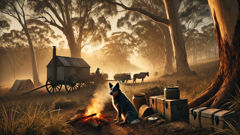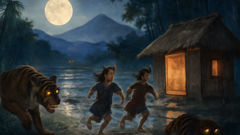Introduction
In the heart of New South Wales, where the gum trees rise like ancient guardians and the Southern Cross twinkles above endless plains, the land itself seems to echo with old stories. It’s a place where red dust clings to boots and memory, where golden wattle blooms frame meandering rivers, and where the air carries a thousand untold yarns whispered by wind and birdsong alike. Among the most cherished of these tales is the legend of the Dog on the Tuckerbox—a story woven into the very soil and spirit of the Australian bush. It’s not just a tale of a dog and a lunchbox, but of the fierce loyalty that blooms in adversity and the deep connection between pioneers and their faithful companions. For generations, children have sat by glowing campfires, listening wide-eyed as elders recounted how a humble bullock driver’s dog came to stand guard over his master’s tuckerbox near Gundagai. Some say it’s a story shaped by hardship, others by the simple kindness that exists between friends—whether two-legged or four. But all agree it’s a legend that stirs the heart, capturing the perseverance and hope that built a nation. As the story unfolds, you’ll journey back to the rough tracks and towering forests of early colonial Australia, where every meal was hard-won and loyalty was worth its weight in gold. Through dust storms and laughter, sorrow and resilience, you’ll meet the people who carved a life from stubborn earth—and the steadfast dog whose love became a lasting symbol beneath southern skies.
Bullock Tracks and Bush Laughter: Gundagai’s Hard Roads
In the early 1830s, the road to Gundagai was nothing more than a stubborn scar across wild country. Ruts from bullock wagons chewed into red earth, and the crossing at Five Mile Creek was infamous among teamsters for swallowing wheels and tempers whole. It was a land both beautiful and unforgiving, where golden afternoons could melt into cold, drizzling nights without warning. Among the men who braved these tracks was Jack O’Reilly, a wiry bullock driver whose Irish laughter could coax a grin from even the most jaded swaggie. His team—eight sturdy bullocks with personalities as varied as the bush itself—hauled loads of supplies and dreams between Sydney and the goldfields, their yokes creaking like old bones. But Jack’s truest companion was Lady, his blue heeler. From the day she’d bounded into his camp as a half-grown pup, Lady had been more than a working dog. She was his shadow and his solace, clever enough to sense a snake in the grass or a storm brewing behind distant hills. At night, when the bush grew thick with cricket-song and uncertainty, she curled close to Jack’s swag, her breath a steady reassurance. Jack’s fellow teamsters often joked that Lady was better company than most men—quieter, too. She would trot beside the wagon, her tongue lolling in the heat, eyes sharp for trouble or a stray calf. At every midday halt, Jack would unpack his battered tin tuckerbox—a patchwork of dents and careful repairs. Inside lay thick slabs of damper, a wedge of cheddar, and occasionally a precious sliver of salted meat. Lady knew the ritual well. She’d wait patiently as Jack shared his meal, her tail thumping softly, always accepting her share with gentle dignity. These moments—simple, unhurried—were the true heart of bush life. For men like Jack, each day was measured in miles covered, wagons mended, and meals eaten with a friend beside you. The road to Gundagai held dangers enough: flash floods, bogged wheels, ill-tempered bulls, and the loneliness that gnawed at a man’s spirit when stars stretched forever overhead. Yet for Jack and Lady, hardship was softened by trust. The pair became known along the track for their easy camaraderie and Jack’s knack for spinning stories around the campfire. Sometimes, he’d laugh that Lady understood English better than most people he met. She’d look up at him with wise, amber eyes, as if agreeing. Their partnership was built on small, daily acts of kindness—Jack’s steady hand, Lady’s loyal gaze—a quiet love that needed no words. In those tough early days, when the journey to Gundagai could take a fortnight and every crossing tested both man and beast, Jack and Lady came to symbolize the grit and warmth that bound bush folk together. They were a living reminder that, in a world of shifting fortunes and endless horizons, loyalty was the surest guide a traveler could have.
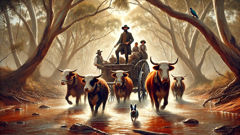
Disaster at Five Mile Creek: Loyalty in the Mire
The land around Gundagai had a habit of changing its face overnight. One evening, just as Jack’s team crested a ridge, dark clouds rolled in from the west. The air thickened, heavy with the scent of rain on dust, and a hush fell over the camp. Jack set up his swag beneath a leaning gum, tucking his tuckerbox nearby and giving Lady an affectionate pat. The bullocks grumbled restlessly as thunder echoed beyond the hills. Night brought a deluge—rain lashing canvas, wind rattling through branches. By dawn, the track to Five Mile Creek had become a boggy quagmire, its banks swollen and treacherous. Jack eyed the crossing with a practiced wariness. He’d heard stories of wagons lost here, swallowed by mud or swept away by flash floods. But he had little choice; the run to Gundagai could wait for no man’s comfort. Lady sniffed the air, hackles twitching. As Jack urged the bullocks into motion, the wagon’s wheels groaned in protest, sinking deeper with every step. Midway across, disaster struck. One of the lead bullocks, spooked by something unseen, lurched sideways. The yoke twisted, pitching the wagon at a dangerous tilt. In a sickening instant, the whole load tipped—crates and canvas spilling into the muck. Jack fought to steady his team, boots vanishing in sticky clay. Rain pelted his face as he scrambled to free the animals, cursing under his breath. The tuckerbox tumbled from its perch, landing on a hummock just above the rising water. Lady darted through the chaos, barking encouragement, her coat slick with rain. She circled Jack, driving off a startled snake and nipping at a bullock’s heel when panic threatened to break the team. For hours, man and dog battled the mire. Jack’s arms shook with fatigue as he cut away harnesses, each movement slower than the last. When at last the bullocks found firmer ground, Jack slumped beside his overturned wagon, hands raw and heart heavy. The road to Gundagai had never seemed so long—or so lonely. Yet even as exhaustion claimed him, Lady remained vigilant. She nosed the tuckerbox, dragging it further up the bank with determined paws. As dusk crept across the flooded landscape, she took up her post atop the battered tin, ears cocked for trouble. Jack, fighting sleep, watched her silhouette outlined against the last light. In that bleak moment, hope flickered. There was comfort in Lady’s steadfastness—in the simple act of guarding a meal neither might eat that night. Jack smiled through cracked lips, whispering gratitude as darkness closed around them. All through that sodden night, Lady stood sentinel by the tuckerbox, her loyalty as constant as the southern stars. She shivered but did not yield, keeping watch over the last treasure her master had left. By morning, when help arrived from a passing teamster, Lady’s devotion had written a story deeper than any wagon rut—a tale of courage and faith that would outlast the storm.
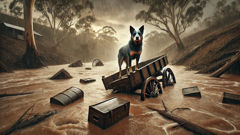
A Monument to Faith: The Dog on the Tuckerbox Endures
Long after the mud dried and wagons rolled on toward Gundagai, the tale of Lady and the tuckerbox echoed up and down the bush tracks. Jack’s rescue—thanks to his loyal dog’s vigilance—became a touchstone for weary travelers, passed from campfire to campfire. It was said that whenever a teamster faced hardship, he need only remember the blue heeler who’d stood by her master’s meal through rain and darkness. As years slipped by, roads improved, but the memory of that stormy night at Five Mile Creek took root in local lore. Some said Lady waited for days until Jack returned; others swore she’d kept vigil until help came, refusing to abandon the tuckerbox even when hunger gnawed at her belly. Over time, the legend grew. Newcomers to Gundagai would ask about the dog who guarded her master’s lunch through thick and thin. The story gained fresh life when it caught the ear of a poet—someone whose words painted the bush with longing and pride. Verses immortalized Lady’s courage, and soon her vigil became more than a memory: it became a symbol for all who had ever faced loss, hardship, or loneliness in a vast land. By the dawn of the 20th century, locals began dreaming of a monument—a way to honor not just Lady, but the unspoken bond between bushfolk and their loyal companions. In 1932, amid drought and depression, townsfolk gathered to unveil a statue at Five Mile Creek. Cast in bronze, the Dog on the Tuckerbox sat atop her lunchbox, gaze fixed steadfastly ahead. People came from far and wide, laying wildflowers and leaving biscuits in thanks. Children pressed their faces to cool metal, imagining Lady’s adventure. For generations since, the statue has stood beside the Hume Highway—a beacon to travelers and a reminder that loyalty endures long after footprints fade. Tourists snap photos, school groups recite the poem, and old-timers nod quietly as they pass by, each remembering their own struggles and the friends who saw them through. Yet perhaps the true legacy of the Dog on the Tuckerbox isn’t found in metal or verse. It lives on in every kind act along the road—in every hand that offers help, in every dog that trots beside a weary soul. In Lady’s story, Australians see something of themselves: the stubborn hope that endures, no matter how rough the track ahead. And so, beneath gum trees and southern stars, the legend endures—a humble lunchbox and a faithful dog forever guarding the heart of a nation.
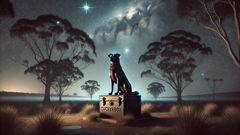
Conclusion
The legend of the Dog on the Tuckerbox remains one of Australia’s most enduring stories—a tale born from hardship, but shaped by resilience and the quiet courage that defines life in the bush. It reminds us that even in our loneliest or most difficult moments, loyalty and hope can shine through, guiding us like a beacon across wild country. For every traveler on life’s long road—whether facing floods, sorrow, or uncertainty—the faithful dog’s vigil near Gundagai speaks to something deeper: the power of companionship and the dignity of small, steadfast acts. Today, as new generations stand before the monument, listening to stories whispered by wind and history, they find not just a memory of one remarkable dog, but a reflection of the Australian spirit itself—unyielding, generous, and always ready to carry on, no matter how muddy the track ahead.

